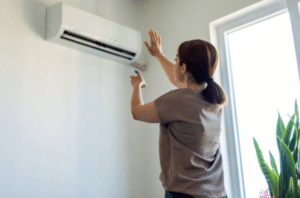If you work in an office in the United Kingdom, you may have noticed a musty odour or strange discolouration on the walls or ceiling.
These could be signs of office mould, a common problem in workplaces that can have serious health implications.
We have seen firsthand the damage that mould can do to office environments. It can cause staining, and structural damage to office walls and furniture.
It can also release harmful spores into the air, which can trigger respiratory problems, allergies, and asthma.
In this article we’ll look into office mould causes and on how they are are often linked to air conditioning systems.
We’ll get to know the factors that contribute to mould problems in office environments and on how it is crucial to prevent and address these issues.
Key Takeaways:
- Office mould causes are often linked to improperly maintained air conditioning systems.
- Factors like humidity, lack of ventilation, and moisture sources like leaks or condensation can contribute to mould growth in offices.
- Preventing office mould growth requires measures like controlling humidity levels and addressing moisture issues promptly.
Understanding the Office Mould Causes
Now that you’re aware of the connection between air conditioning systems and mould growth, it’s important to understand all the factors that contribute to mould in the workplace.
mould thrives in environments that are warm and damp, so offices that experience high humidity levels are at a higher risk of mould growth.
Lack of ventilation can also contribute to the buildup of moisture, as can water leaks or condensation from pipes, roofing, or windows.
Poor air quality can also contribute to mould growth. This can include air contamination from external sources or airborne pollutants within the building.
It’s crucial to be aware of these factors, as they provide a breeding ground for mould spores, which can quickly multiply and spread throughout the workplace.
Controlling Humidity Levels
One of the keys to preventing mould is controlling humidity levels. The ideal humidity level for offices is between 30% to 60%. Investing in a dehumidifier can help to regulate and maintain these levels.
Additionally, regularly checking and emptying drip pans from air conditioning units can prevent excess moisture from building up.
Improving Ventilation
Improving ventilation is another crucial factor in preventing mould growth. Good airflow can prevent moisture from accumulating in the air and on surfaces.
This can include factors such as opening windows, installing additional fans, or using air purifiers to clean the air.
Promptly Addressing Leaks or Moisture Issues
Addressing any water leaks or moisture issues in the workplace is critical in preventing mould growth.
Any leaks or spills should be addressed immediately to prevent the moisture from seeping into the walls or floors.
Additionally, any water-damaged materials should be replaced as soon as possible to prevent mould growth.
By being aware of the factors that contribute to mould growth, you can take steps to prevent mould problems in your workplace.
In the next section, we’ll dive deeper into the role that air conditioning systems play in mould growth and how to prevent it.
The Role of Air Conditioning Systems in mould Growth
If you work in an office, you’re likely familiar with the sound of the air conditioning running for hours on end.
While it may keep you cool and comfortable, did you know that your office’s air conditioning system could also be contributing to mould growth?
mould thrives in environments with high humidity and moisture levels, making air conditioning systems a prime location for growth.
If your office’s air conditioning system is not properly maintained, it can create a breeding ground for mould spores to develop and spread.
| Common sources of mould growth in air conditioning systems | Impact on office occupants |
|---|---|
| Moisture buildup in the air handler unit | Increased risk of respiratory issues, allergies, and other health problems |
| Clogged drain lines or drip pans | Unpleasant odors, reduced air quality, and potential property damage |
| Ductwork condensation | Discoloration of walls and ceilings, as well as a musty smell |
Preventative maintenance is key to preventing mould growth in air conditioning systems. Regular inspections and cleaning of the unit, ductwork, and drip pans can help keep moisture levels under control and inhibit mould growth.
Additionally, it’s important to address any water leaks or moisture issues promptly to prevent mould from spreading to other areas of the building.
Don’t overlook the role that your office’s air conditioning system plays in mould growth. By taking preventative measures and staying vigilant, you can create a safe and healthy work environment for yourself and your colleagues.
Preventing Office mould Growth
To prevent office mould growth, it is essential to take proactive measures to identify and address any underlying causes. Follow these practical tips and recommendations:
- Maintain humidity levels between 30-60% to minimise moisture in the air.
- Ensure adequate ventilation by opening windows or running HVAC systems.
- Address water leaks or moisture sources promptly and thoroughly.
- Conduct regular cleaning and maintenance of surfaces and HVAC systems.
- Promote awareness among employees of the risks associated with mould growth and the steps they can take to prevent it.
By implementing these measures, you can create a healthy office environment and prevent the root causes of office mould from developing.
Recognising the Signs of mould Issues in Work Environments
As a responsible office manager, you need to be aware of the signs of mould growth in your workplace. mould can be hidden and go undetected for a long time, but it can cause serious health problems and affect the work environment.
Here are some common indicators of mould problems in office buildings:
- Musty or earthy odors
- Persistent respiratory symptoms among employees, such as coughing, sneezing, and wheezing
- Visible mould growth on surfaces such as ceilings, walls, and floors
- Water stains or discoloration on surfaces
- Condensation on windows or other surfaces
If you notice any of these signs, it is crucial to take prompt action to prevent the mould from spreading and causing further damage.
The Dangers of DIY mould Removal in Offices
If you discover mould in your office, your first instinct may be to attempt to remove it yourself.
However, DIY mould removal can be a dangerous undertaking. mould spores can pose serious health risks, and improper removal can cause them to spread throughout the office.
While it may be tempting to save money by handling the problem on your own, the risks far outweigh the potential benefits.
Instead, it is best to seek professional assistance from a trusted mould removal service like AirFresh Mould Removal London.
Professional mould removal services have the expertise and specialised equipment necessary to safely and thoroughly remove mould from your office.
Attempting to remove mould on your own can lead to further damage and contamination, potentially causing more harm than good.
Furthermore, improper DIY mould removal can also result in legal and financial consequences for your business.
If mould contamination is not properly addressed, it can lead to costly liability claims and damage to your reputation.
Don’t risk the health and safety of yourself and your employees. Contact a professional mould removal service for safe and effective mould remediation in your office.
The Importance of Calling a Professional Mould Removal Service
If you have detected any signs of mould growth in your office, it is crucial to seek professional help. Attempting to remove mould by yourself can be risky and may not provide a permanent solution.
Here are some key reasons why you should consider calling a professional mould removal service.
Expertise: Professional mould removal services have the skills and knowledge to identify the root causes of mould growth and implement effective removal strategies.
Specialised equipment: Professional services use industry-grade equipment to thoroughly remove mould and address any underlying moisture issues.
Health risks: Exposure to mould can cause a range of health issues, particularly in vulnerable individuals such as those with allergies or respiratory conditions. Professional services can ensure that the mould is safely and completely removed, reducing the risk of health problems.
Time and cost savings: Attempting to remove mould on your own can be time-consuming and costly, as you may not have the necessary equipment or expertise. Hiring professional services can save you time and money in the long run by providing a quick and effective solution.
Overall, calling a professional mould cleaning service like AirFresh Mould Removal London can ensure that your office environment is safe, healthy, and free from mould growth.
Expert Mould Cleaning Service in London
If you suspect your office may have a mould problem, it’s important to address it as soon as possible. Attempting to remove the mould on your own can be dangerous and ineffective. That’s where AirFresh Mould Specialists London comes in.
With years of experience in the industry, AirFresh Mould Removal London provides expert mould cleaning services for commercial properties like offices across the London area.
Our team of professionals uses specialised equipment and techniques to ensure that the mould is completely eradicated, and all affected areas of your office are thoroughly cleaned and disinfected.
We understand the urgency of removing mould in the office environment, and that’s why our team is available 24/7 to respond to your needs.
We pride ourselves on our commitment to delivering high-quality service and satisfaction to our clients. With AirFresh Mould Removal London, you can be confident that your office environment will be safe and healthy for everyone.
The Impact of Mould on Health and Office Environment
Mould growth in office spaces can have a significant impact on both the health of employees and the overall office environment.
When mould spores are present in the air, they can cause a range of respiratory issues, including coughing, wheezing, and throat irritation. In some cases, exposure to mould can even trigger asthma attacks or cause allergic reactions.
It’s not just the health of employees that is affected by mould growth in offices. The presence of mould can also compromise the structural integrity of the building, causing damage to walls, ceilings, and other surfaces.
Additionally, mould can give off an unpleasant and musty odour, which can make the office environment less pleasant and welcoming.
Research has also shown that mould in the workplace can have a negative impact on employee productivity and morale.
When employees are exposed to mould and its associated health risks, they are more likely to suffer from absenteeism and presenteeism, which can reduce productivity levels and affect the overall success of the business.
Overall, it’s clear that addressing office mould causes should be a top priority for employers and building owners.
By taking steps to prevent mould growth and seeking professional assistance when necessary, you can help protect the health and well-being of your employees while also maintaining a safe and positive work environment.
Taking Action for a Healthy Office Environment
Preventing mould growth in your office is essential for maintaining the health and well-being of your employees. Here are some actionable steps you can take:
Maintain proper humidity levels: Keep the humidity level in your office between 30-60% to prevent excess moisture in the air.
Improve ventilation: Make sure your office has proper ventilation to ensure fresh air is circulating and moisture levels are kept low.
Fix water leaks: Address any water leaks or moisture sources immediately to prevent mould growth.
Regular cleaning: Implement a regular cleaning schedule and ensure that high-risk areas, such as bathrooms and kitchens, are cleaned frequently.
Promote awareness: Educate your employees on the signs of mould growth and encourage them to report any issues or concerns to management.
By following these steps, you can create a healthy office environment and prevent mould growth from occurring in the first place.
The Importance of Prioritising mould Prevention in Offices
If you want to maintain a healthy and productive work environment, it’s essential to prioritise mould prevention in your office.
Not only can mould growth impact your employees’ health, but it can also lead to costly repairs and damage to your reputation.
By addressing the root causes of office mould causes, such as poor ventilation and moisture sources, you can prevent mould growth from occurring in the first place. Regular maintenance and cleaning routines can also help keep your office free of mould spores.
It’s important to raise awareness among employees about the significance of mould prevention and encourage them to report any signs of mould issues in a timely manner.
This can help prevent mould growth from spreading and minimise the potential impact on employee health.
Remember, if you do encounter mould issues in your office, it’s crucial to seek professional assistance from a reputable mould removal service.
Attempting to remove mould yourself can be dangerous and may not be thorough enough to eradicate the issue completely.
By prioritising mould prevention in your office, you can create a safer and healthier working environment for your employees and protect your business from costly mould remediation and reputation damage.
Studies and data on office mould in the UK
According to a study by the Health and Safety Executive (HSE), mould is the most common cause of sick building syndrome (SBS) in the UK. SBS is a group of symptoms that can occur when people spend time in a poorly ventilated or humid environment. Symptoms of SBS can include headaches, fatigue, respiratory problems and eye irritation.
The HSE study found that 25% of office workers in the UK had experienced symptoms of SBS in the past year. The study also found that the risk of SBS was higher in offices with high humidity levels.
Mould thrives in humid environments. The ideal humidity level for offices is between 40% and 60%. However, humidity levels in offices can often be higher than this, especially in the summer months.
These studies highlight the importance of controlling humidity levels in offices to prevent mould growth and protect the health of office workers.
Conclusion
Now that you understand the connection between air conditioning systems and mould growth in UK offices, it’s important to take action to prevent any potential mould issues.
Remember that factors such as humidity, lack of ventilation, and moisture sources can contribute to mould growth in your workplace, so it’s important to address these as soon as possible.
If you notice any signs of mould, such as musty odours or visible growth, it’s essential that you take immediate action.
Attempting to remove mould yourself can be dangerous, so it’s best to leave it to the professionals. AirFresh Mould Removal London can provide the necessary expertise and equipment for safe and thorough mould remediation in your commercial property.
By prioritising preventative measures, promoting good ventilation, and regularly maintaining your air conditioning systems, you can create a healthier and more productive office environment.
Don’t underestimate the impact of mould on your health, your employees’ wellbeing, and your business’s reputation.
Protect yourself and your colleagues by taking proactive steps to prevent mould growth in your office.
FAQ
Q: What are the common factors causing mould in the workplace?
A: Factors such as high humidity, lack of ventilation, and moisture sources like leaks or condensation contribute to mould growth in office spaces.
Q: How does air conditioning system affect mould growth in offices?
A: Improperly maintained HVAC systems can create a favorable environment for mould spores to thrive, making air conditioning systems a common source of mould in offices.
Q: What can I do to prevent mould growth in my office building?
A: Controlling humidity levels, improving ventilation, addressing water leaks or moisture issues promptly, and implementing regular cleaning and maintenance routines can help prevent mould growth in office buildings.
Q: What are the signs of mould issues in work environments?
A: Musty odors, visible mould growth, and persistent respiratory symptoms among employees are common signs of mould problems in work environments.
Q: Is it safe to attempt DIY mould removal in offices?
A: No, attempting to remove mould in offices without professional assistance can be risky as it exposes individuals to potential health hazards associated with mould spores.
Q: Why is it important to call a professional mould removal service for commercial properties?
A: Professional mould removal services possess the expertise and specialised equipment necessary for thorough and safe mould remediation in commercial properties like offices.
Q: Who is AirFresh Mould Removal London?
A: AirFresh Mould Experts London is an expert mould cleaning service provider in the London area, offering professional and high-quality mould removal services.
Q: What are the health and environmental impacts of mould in office settings?
A: mould in office settings can lead to health risks such as allergic reactions and respiratory issues, as well as negatively impact the overall office environment.
Q: What steps can I take to create a healthy office environment and prevent mould growth?
A: Regular maintenance, promoting good ventilation, addressing moisture issues promptly, and raising awareness among employees are some actionable steps to create a healthy office environment and prevent mould growth.
Q: Why is it important to prioritise mould prevention in offices?
A: Addressing mould causes proactively is important to avoid the financial and reputational costs associated with mould issues, as well as to maintain employee well-being and productivity.
Now that you know the causes of office mould and its link to air conditioning, are you going to wait further for mould to spread in your premises?
Call us today at 0203 130 4068 to get a free consultation and learn more about how we can help you keep your office mould-free.




